
Yucca is a genus of perennial shrubs and trees in the family Asparagaceae, subfamily Agavoideae. Its 40–50 species are notable for their rosettes of evergreen, tough, sword-shaped leaves and large terminal panicles of white or whitish flowers. They are native to the Americas and the Caribbean in a wide range of habitats, from humid rainforest and wet subtropical ecosystems to the hot and dry (arid) deserts and savanna.
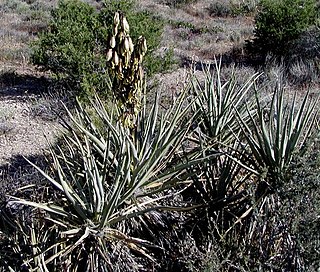
Yucca baccata is a common species of yucca native to the deserts of the southwestern United States and northwestern Mexico, from southeastern California north to Utah, east to western Texas and south to Sonora and Chihuahua. It is also reported in the wild in Colombia.

Thymelicus lineola, known in Europe as the Essex skipper and in North America as the European skipper, is a species of butterfly in the family Hesperiidae.

Grass skippers or banded skippers are butterflies of the subfamily Hesperiinae, part of the skipper family, Hesperiidae. The subfamily was established by Pierre André Latreille in 1809.

The Lumber River, sometimes referred to as the Lumbee River, is a 133-mile-long (214 km) river in south-central North Carolina in the flat Coastal Plain. European settlers first called the river Drowning Creek, which is still used as the name of its headwater. The waterway known as the Lumber River extends downstream from the Scotland County-Hoke County border to the North Carolina-South Carolina border. Soon after crossing into South Carolina, the Lumber River flows into the Little Pee Dee River, which flows into the Pee Dee River, or Great Pee Dee River. Finally, the combined waters flow into Winyah Bay and the Atlantic Ocean.

Yucca gigantea is a species of flowering plant in the asparagus family, native to Mexico and Central America. Growing up to 8–12 m (26–39 ft) in height, it is an evergreen shrub which is widely cultivated as an ornamental garden or house plant, often referred to simply as yucca cane. The edible flower is the national flower of El Salvador locally called izote, and it is used extensively in Salvadoran cuisine.
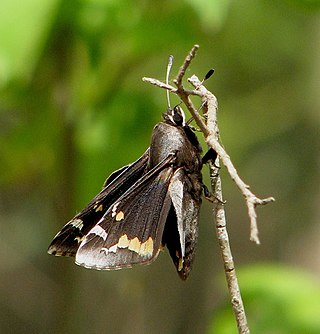
Megathymus is a genus of butterflies in the skipper family, Hesperiidae.

Anatrytone logan, the Delaware skipper, is a North American butterfly. It is a member of the subfamily Hesperiinae, the grass skippers. This skipper ranges from the southern Canadian Prairies and southern Ontario through the midwestern and eastern United States.
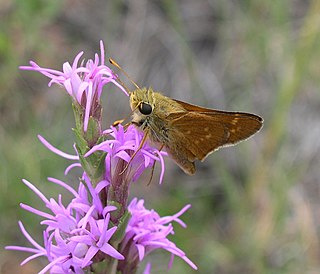
Hesperia leonardus, the Leonard's skipper, is a butterfly of the family Hesperiidae. There are three subspecies. Next to the nominate species, these are the Pawnee skipper, which is found in North America from western Montana and south-eastern Saskatchewan east to Minnesota, south to central Colorado and Kansas. Leonard's skipper ranges from Nova Scotia and Maine west through southern Ontario and the Great Lakes region to Minnesota, south to North Carolina, Louisiana and Missouri and the Pawnee montane skipper is endemic to the South Platte River drainage of Colorado.

Hesperia uncas, the Uncas skipper or white-vein skipper, is a butterfly of the family Hesperiidae. It is found from US Midwest to southern portions of the three Canadian Prairie provinces, north as far as Edmonton, Alberta.

Polites origenes, the crossline skipper, is a butterfly in the family Hesperiidae. It is found in the eastern United States, excepting Florida, southern Ontario, and Quebec.

Euphyes vestris, the dun skipper, sedge witch or dun sedge skipper, is a species of butterfly of the family Hesperiidae. It is found in North America from Nova Scotia west across southern Canada to southern Alberta, south to Florida, the Gulf Coast and eastern Texas. There are disjunct populations in the High Plains and Rocky Mountains and along the Pacific Coast.
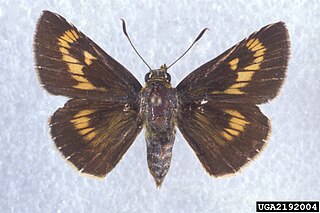
Problema byssus, the byssus skipper or bunchgrass skipper, is a butterfly of the family Hesperiidae. It is found along the Atlantic coastal plain of North America, from North Carolina south to Florida and the Gulf States and from northern Indiana west to Iowa and south to Missouri and Kansas.

Problema bulenta, the rare skipper, is a butterfly of the family Hesperiidae. It is hard to find within the United States. The species was first described based on a drawing.
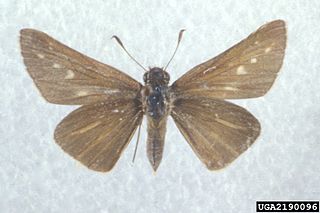
Panoquina panoquin, the salt marsh skipper, is a butterfly of the family Hesperiidae. It is found along the Atlantic Coast of the United States, from New York south to Florida and the Florida Keys, west along the Gulf Coast to southern Texas.

Megathymus streckeri, or Strecker's giant skipper, is butterfly of the family Hesperiidae. It is found in the United States from southeastern Montana and southwestern North Dakota south to southern Texas and west to northwestern Arizona and southwestern Utah. Its habitats include short grass prairies, sand hills, and rocky bluffs.

Charles F. Harbison (1904–1989) was an American entomologist and the curator of entomology at the San Diego Natural History Museum from 1942 to 1969. An avid field naturalist and researcher, Harbison influenced a generation of San Diego-born scientists in many fields of natural history through the Junior Naturalist program at the museum.

Megathymus cofaqui, the Cofaqui giant-skipper, is a butterfly in the family Hesperiidae. Its range is limited to a north–south swath through the middle of Georgia in the United States.



















